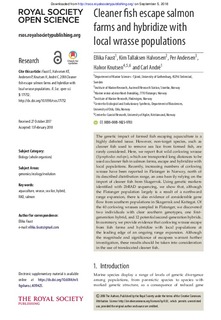Cleaner fish escape salmon farms and hybridize with local wrasse populations
Journal article, Peer reviewed
Published version
Permanent lenke
http://hdl.handle.net/11250/2561755Utgivelsesdato
2018Metadata
Vis full innførselSamlinger
- Articles [3016]
- Publikasjoner fra CRIStin [3074]
Sammendrag
The genetic impact of farmed fish escaping aquaculture is a highly debated issue. However, non-target species, such as cleaner fish used to remove sea lice from farmed fish, are rarely considered. Here, we report that wild corkwing wrasse (Symphodus melops), which are transported long distances to be used as cleaner fish in salmon farms, escape and hybridize with local populations. Recently, increasing numbers of corkwing wrasse have been reported in Flatanger in Norway, north of its described distribution range, an area heavily relying on the import of cleaner fish from Skagerrak. Using genetic markers identified with 2bRAD sequencing, we show that, although the Flatanger population largely is a result of a northward range expansion, there is also evidence of considerable gene flow from southern populations in Skagerrak and Kattegat. Of the 40 corkwing wrasses sampled in Flatanger, we discovered two individuals with clear southern genotypes, one first-generation hybrid, and 12 potential second-generation hybrids. In summary, we provide evidence that corkwing wrasse escape from fish farms and hybridize with local populations at the leading edge of an ongoing range expansion. Although the magnitude and significance of escapees warrant further investigation, these results should be taken into consideration in the use of translocated cleaner fish.
